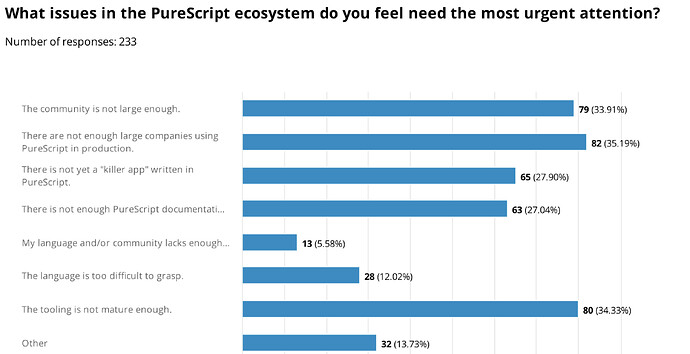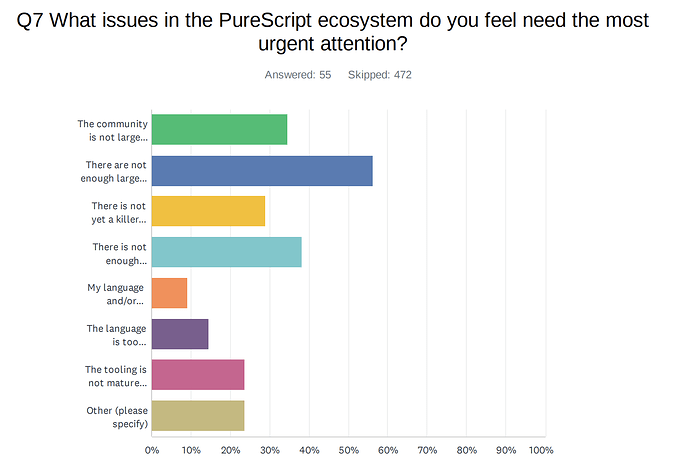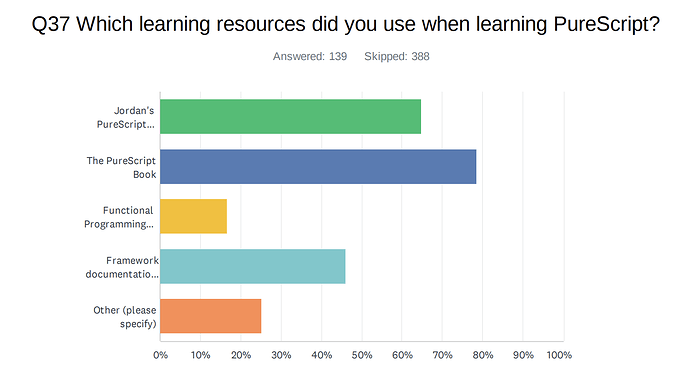The PureScript 2023 Survey
The results are in! PureScript’s second annual survey revealed some key trends about the language and the broader context of functional programming. You can download the full results here, and you can read on to see the core team’s high-level analysis of these results.
Tooling
Last year, tooling was a major concern of folks that had stopped using or had never used PureScript.
In the past year, the following improvements in tooling were made:
- The new
registry(currently in alpha) automates and streamlines the package management process. - The
spagorewrite is in active development and nearing an alpha release (though some are already using it). It avoids several pitfalls of the previous Haskell-basedspago, adds support for some highly-requested features, and hopes to garner more contributions in the future by being written in PureScript. - The
purs-backend-estool outputs JavaScript that is more readable and has significantly faster execution than the JavaScript outputted by the PureScript compiler.
The concern about tooling has gone down on-average by 8%, likely due to some of the improvements above. Here’s the 2023 response for those who are no longer using PureScript:
And here’s the same response by those who have not used PureScript:
Documentation
Like last year, folks identified documentation as an impediment to using the language. For those who have never used the language, it is still the biggest barrier to entry.
The qualitative responses about documentation revealed three clear areas where there is room for improvement:
- a desire to see more up-to-date official documentation.
- confusion about how to get up and running on a project of type X given experience with Y.
- frustration with a lack of clarity around tooling - while tooling has improved, there is still a lot of it out there, and it’s not clear when certain legacy tooling will be deprecated.
The quantitative answers show that free learning resources (e.g. PureScript by Example, Jordan’s PureScript Reference, and various framework documention (likely Halogen or something similiar)) are used more often than paid ones (e.g. Functional Programming Made Easier).
Unfortunately, the survey didn’t ask additional questions like
- How helpful was each resource?
- At what point did you start/stop using a given resource?
PureScript by Example is the learning resource officially promoted on the PureScript webpage. However, it does not currently have a person maintaining and improving it, and there are definitely places where it is no longer up-to-date. It might be time to feature something else in its place, such as Functional Programming Made Easier because the other top resource, Jordan’s PureScript Reference, is more of a reference and less of a step-by-step learning guide.
63% of respondents identified that written material is important in their learning journey, so it would make sense to align the materials we promote with the ones that the community finds most useful. However, it’s also clear that participating in online communities, building applications and reading through source code are meaningful learning pathways for folks working with PureScript.
Because our documentation isn’t as strong as it could be, it’s likely that folks who are currently proficient with the language got there by being auto-didactic, so we can’t necessarily draw the conclusion that the 2023 figures would stay the same if we had stronger documentation. That being said, the focus on learning from building applications aligns with another strong trend we identified: a desire to see more large-scale PureScript production deployments.
Production deployments
Several data points have led us to the conclusion that a dearth of PureScript production deployments is the largest concern of both those inside the community and those who have left the community:
- 56% of folks that have stopped using PureScript identify the lack of large companies using PureScript in production as the most urgent issue we’re facing: a whopping 22% higher than the next-highest concern.
- when asked “What are your biggest worries for the future of PureScript?”, 70% of current PureScript developers identified “Not enough usage in industry” as the biggest concern, dwarfing the next response by 25 percentage points.
- only 18% of respondents that use PureScript regularly work in companies that are planning on hiring PureScript developers.
- 25% of respondents strongly disagree with the statement “It is easy for qualified applicants to find jobs which use PureScript for the majority of programming.”
At the same time, for those using PureScript in industry, 42% responded that their company uses PureScript for a large portion of their production projects. So while significant production deployments do exist, they are either not well-known enough or not numerous enough to assuage folks’ concerns about a lack of production deployments, and they are not large enough to sustain a robust PureScript-development job market.
Unlike documentation, PureScript’s usage in industry is difficult to directly influence in the short term. In the long-term, investments in better tooling and documentation all translate to more production deployments, but we do not yet see a clear path towards improving the PureScript-in-industry situation during 2023. What we can do is identify opportunities to more prominently feature companies using PureScript.
For example, PureScript’s new es-backend was created by developers at Arista NDR specifically to aid with their production stack. Other companies have made similar contributions to PureScript’s backend ecosystem, such as id3as via the purerl backend for Erlang and Meeshkan via the purescript-python backend for Python. While the purescm backend has not yet been used in production, it has improved significantly in recent months, and it will be insteresting to see if it matures to the point where it can be used in industrial stacks. We look forward to making those connections more evident through our official materials.
PureScript Developers  PureScript
PureScript
Like last year, we saw strong signals that those using PureScript love using PureScript.
- 97% of those using PureScript agree with the statement “PureScript is fun to use.”
- 97% of those using PureScript agree with the statement “PureScript provides a real benefit over other programming languages.”
- 75% of those using PureScript agree with the statement “PureScript makes me more productive.”
- 84% of those using PureScript agree with the statement “PureScript code tends to contain significantly fewer bugs than equivalent code written in another programming language.”
Furthermore, the vast majority of PureScript developers feel welcome on our main community channels.
So while there are short-term concerns about documentation and long-term concerns about industry adoption that we’ll need to address as a community, it’s important to acknowledge that PureScripters have a great thing going with the language as it currently stands.
Conclusion
While PureScript’s 2023 survey followed the general contours of the 2022 survey, it’s clear that the improvements in tooling moved the needle in the 2023 responses. We hope that we can be as intentional and impactful as we look to translate this year’s results into actionable items.
If you haven’t used PureScript yet or are discovering PureScript for the first time, you’re more than welcome to say hi on our Discord, read about someone’s learning journey, or read a framework’s tutorial. Only a handful of programming languages are as loved by their community as PureScript is, so we’re excited to share the good vibes with eager and curious minds. Rendez-vous in 2024 for the next survey and, until then, we look forward to seeing exciting applications and novel ideas continue to emerge from our awesome community!



